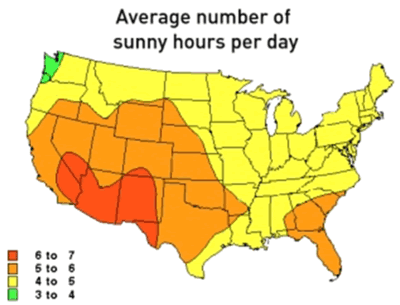|
What is "PV"?
PV is short for photovoltaic (photo=light, voltaic=electricity), another term for solar
power. PV is a semiconductor-based technology used to convert light energy into
direct current electricity, without using moving parts, producing noise, consuming fuel,
or creating pollution. The words "solar electric" and "PV" are used interchangeably.
back to top
How long has Solar Power been around?
The photovoltaic effect was first recognized in 1839 by Edmund Becquerel, in France.
However it was not until 1883 that the first solar cell was built by Charles Frits, who
coated the semiconductor selenium with an extremely thin layer of gold to form the
junctions. Several decades later, in the mid-1950s, the first practical solar cells were
developed at Bell Labs and RCA Labs.
back to top
How do I know which kit will provide enough electricity for me?
This depends on 2 main factors:
- HISTORICAL ELECTRICAL CONSUMPTION: Your first step is to look at your electricity bills for the last 12-24 months and then determine your average monthly kWh consumption . How do you do this? Most utility companies have websites that allow you to access your account and view past statements or you can simply call them up and make a request. The Customer Service Agent should be able to tell you what your average monthly kilowatt consumption.
- AMOUNT OF SUNSHINE: Where is your home or business located? Take a look at the map below.

- DO THE MATH: If you consume 1000kWh per month and you receive 5 hours per day of sunshine: That's 150 hours per 30 day month (5 X 30). 900kWh/150h = 6kW system. Energy Grid Solutions' pricing direct to the consumer is set-up to minimize your initial investment by offering the best prices available which, along with government incentives and rebates, make going solar extremely affordable.
back to top
How much does a Solar System cost?
A solar system involves PV equipment installation, conduit, miscellaneous wiring and
building permits. Energy Grid Solutions will provide a quote for designing and installing an entire
solar system. System costs begin at $9,000 per kilowatt, but a federal tax credit and
state government rebates can reduce your cost by 25 to 50 percent, depending on your
state. Some states also offer tax credits.
back to top
What size system do I need?
Any size solar system will lower your power use. The bigger your system, the bigger
the impact, up to eliminating your electric bill. Energy Grid Solutions will help you determine the
size you need based on your usage needs, your location, your roof and other factors.
However as a general guide, an average 2,000 square foot home running typical
appliances will use approximately 10,000 kilowatt-hours per year. A typical 4 kilowatt
AC solar system will produce around 7,200* kilowatt-hours, enough energy to offset
almost 75% of the home's electrical needs. To figure out how many kilowatt-hours you
use in a year, check your annual electric bills.
back to top
Will this heat my hot water?
Not if your hot water tank is heated with natural gas. We sell solar electric
(photovoltaic) systems that provide electricity for your home.
back to top
What happens after the sun goes down?
Energy Grid Solutions solar systems are connected to the grid, which acts like a battery for your solar
system. During sunny days when your solar system generates more power than your
home needs, your electric meter actually reverses direction and spins backwards as
you lend that energy to the grid. When the sun goes down, you effectively retrieve that
energy when you need it. This process is called Net Metering.
back to top
Will the utility pay me for the kilowatt-hours I lend to the grid?
Most utilities will not pay you, but rather offer you credit for the kilowatt-hours you
generate, allowing you to retrieve them when needed. Most Power Company’s will settle your bill on an
annual basis, but will never "cut you a check". Therefore, it's not advisable to size your
system to generate an annual surplus of electricity.
back to top
How much weight does the system add to the roof?
The system weighs about 3 pounds per square foot. A 1-kilowatt system requires
approximately 100 square feet of surface area. The weight density of the panels is
similar to the weight of common asphalt shingle roofing material and can be used on
almost any roof.
back to top
On what types of roofs can PV be installed?
PV can be installed on any roofing material. Installation costs vary according to the
type of roof.
back to top
Is an Energy Grid Solutions Solar system right for my home?
We will check your roof orientation, the amount of roof space available, whether any
shadows or roof interruptions limit your solar system size, and your recent electricity
usage. The best location for a solar system is an open, unshaded and uninterrupted
south-facing roof. Homeowners sometimes use more than one roof area to maximize
their solar power generation.
back to top
Will my Home Owners Association(HOA) allow me to install a PV system?
In most states, Home Owners Associations cannot legally disallow the installation of
a solar system, though some restrictions may be imposed. Energy Grid Solutions is experienced
in working with both the owner and the Home Owners Association to ensure a smooth
installation. In addition, Energy Grid Solutions focus on aesthetics tends to ease the concerns
of the HOA in terms of the system's impact on the roofline.
back to top
How does the rebate program work?
Rebate programs vary from state to state but, in general, can make a significant
contribution to reducing the overall cost of your installation. Energy Grid Solutions will be able to
manage most of the requirements for the rebate on your behalf, making it simple and
convenient for you.
back to top
|
